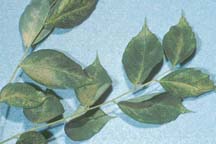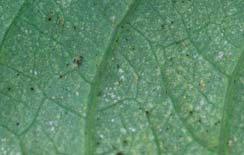Twospotted Spider Mite | |
|---|---|
| August 1, 2006 | |
|
The warm weather we have been experiencing throughout the state means it is time to be cognizant of the potential damage caused by twospotted spider mite, Tetranychus urticae. Twospotted spider mites are considered warm-weather mites because they are mainly active from late spring through early fall. Summer temperatures allow twospotted spider mites to reproduce faster, so that they overwhelm natural enemy populations, which under moderate temperatures are able to control them. Twospotted spider mites have a very broad host range, feeding on a wide range of trees and shrubs including ash, azalea, black locust, elm, euonymus, maple, oak, poplar, redbud, and rose. Twospotted spider mites also feed on many herbaceous annuals and perennials, such as marigold, pansy, aquilegia, buddleia, clematis, daylily, delphinium, phlox, rudbeckia, salvia, Shasta daisy, and verbena.  Twospotted spider mite damage on Kentucky coffeetree.  Closeup of spider mites. Adults are oval and about 1/16 inch long. They vary in color from green–yellow to red–orange. The adults possess two lateral dark spots that are visible when the spider mite is viewed from above. Both adults and nymphs may be found on all plants parts; however, they are often more numerous on older leaves. Twospotted spider mites produce a fine silk, which may be seen between leaves, and the petiole and stem. The webbing produced by twospotted spider mites protects them from predators. Heavy rainfall disrupts and removes this webbing. Twospotted spider mites feed on leaf undersides, removing chlorophyll (the green pigment) from individual plant cells, with their styletlike mouthparts. The spider mites feed near the leaf midrib and veins because this is where the highest concentrations of amino acids are located. Leaves are stippled in appearance, with silvery gray to yellow speckles. Heavily infested leaves appear bronzed, turn brown, and eventually fall off. The warm and dry conditions of summer favor rapid development of twospotted spider mites, in addition to increased feeding and reproduction. The life cycle from egg to adult occurs within 5 days at 75ºF. Twospotted spider mite females don’t have to mate to reproduce (= parthenogenesis) laying up to 300 eggs during their 2- to 4-week lifespan. Twospotted spider mites spend the winter in protected places, including weeds, leaf litter, and debris, which mean that applications of dormant oil are not effective against this spider mite species. Twospotted spider mite management involves sustaining plant health, implementing sanitation practices, and/or using pest control materials (miticides). Avoid exposing plants to any “stress,” through maintaining proper watering, fertility, and mulching—as this will at least reduce any potential problems with twospotted spider mites. For example, inadequate moisture or overfertilizing plants, particularly with nitrogen-based fertilizers, may result in the development of excessive spider mite populations. It is always recommended to monitor for twospotted spider mites by knocking the spider mites off plant parts such as branches, onto a white sheet of paper. This allows you to observe the spider mites more easily. Plant-feeding or phytophagous spider mites typically leave a green streak when crushed, whereas predatory mites leave a red streak. A very effective and rapid method of dealing with twospotted spider mites is to apply a hard water spray, which dislodges eggs and any live spider mites. This also preserves any natural enemies. The removal of plant debris and weeds eliminates overwintering sites. Additionally, many broadleaf and grassy weeds are hosts for twospotted spider mites. Pest control materials, in this case insecticides/miticides, recommended for controlling twospotted spider mites in outdoor environments include abamectin (Avid), bifenthrin (Talstar), etoxazole (TetraSan), hexythiazox (Hexygon), insecticidal soap, and horticultural (= summer) oil. Avid has translaminar properties, which means that the active ingredient penetrates the leaf surface and resides in leaf tissues, thus killing spider mites feeding on the leaf underside even after spray residues have dried. TetraSan is a spider mite growth-regulator that inhibits the molting process. TetraSan is active on the egg, larvae, and nymphal stages, with minimal effect on adult spider mites. However, treated adult female spider mites do not produce viable eggs. TetraSan also has tranlaminar properties similar to Avid. Hexygon is active on the eggs and nymphal stages, with no activity on spider mite adults. Be sure to make applications before twospotted spider mite populations are “high” and causing aesthetic injury. Many pest control materials used to control other insects, such as plant-feeding beetles and caterpillars, may be harmful to the natural enemies of twospotted spider mite, thus leading to an inadvertent increase in twospotted spider mite populations. |